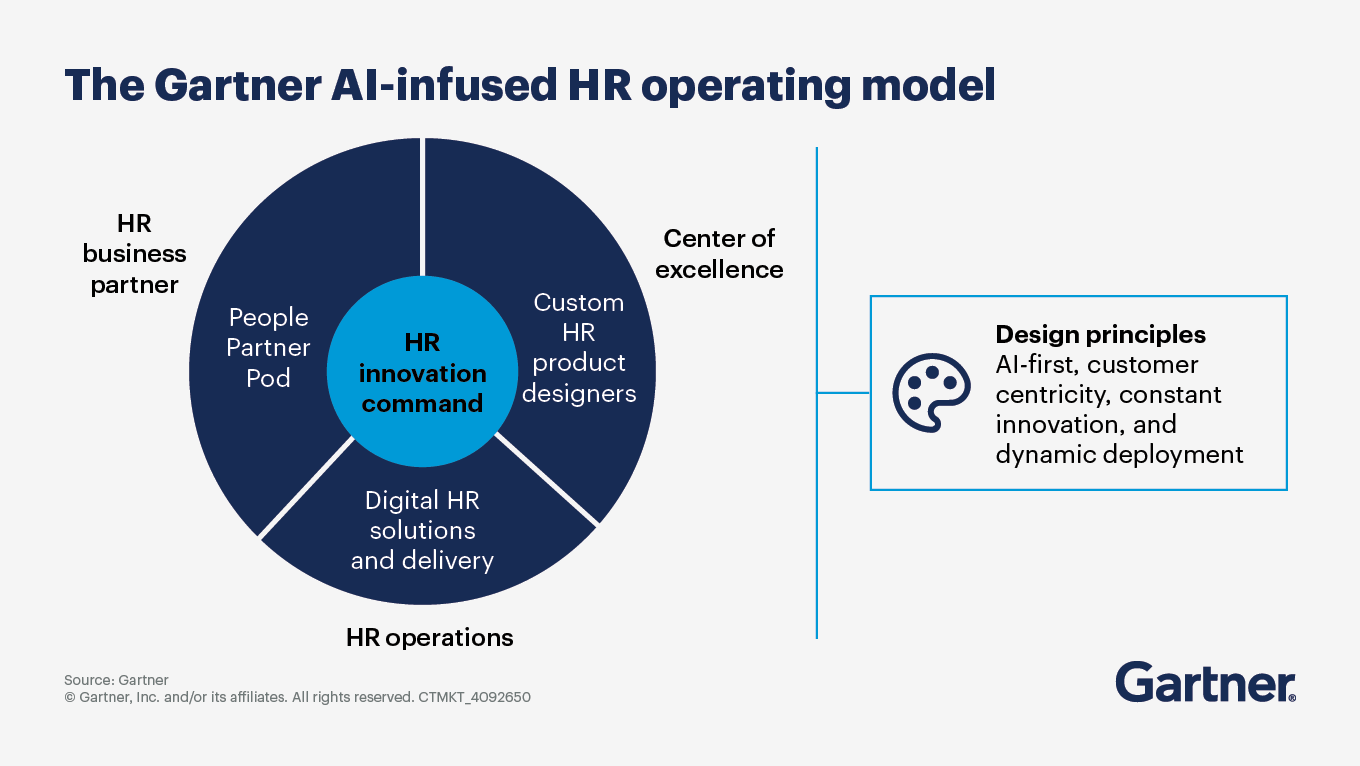CHRO guidance to rethink HR's work, roles and strategy for HR.
- Gartner client? Log in for personalized search results.
AI in HR: Evolve to an AI-Infused HR Operating Model
How AI in HR will reshape the AI-infused HR operating model
AI — especially AI agents — is already transforming HR. In fact, 26% of HR leaders are already underway with an AI-first operating model. CHROs must act now to evolve toward an AI-infused operating model or risk falling behind. But where do you start?
Download Gartner’s AI checklist for CHROs and learn:
- Three ways AI will change HR operating models
- How to rethink HR’s work, roles and ways of working in an AI-driven environment
- Gartner resources for AI success, like diagnostics, benchmarks, guides and toolkits
See Gartner research in action at our HR conferences and events.
To drive real value from AI, HR leaders must move from pilots to practical impact
CHROs and HR leaders who act now will shape how AI redefines HR — benchmark your progress, prioritize smart investments and prepare your workforce for what’s next.
Prepare for AI Adoption
Plan for Workforce Impact
AI-Ready HR
Plan for Agentic AI
Integrate AI into HR to enhance efficiency and drive innovation.
AI is no longer just a tool — it’s a top CHRO priority. It’s transforming how CHROs and HR leaders drive efficiency, innovation and employee engagement. To stay ahead, CHROs and HR leaders must reshape the AI-infused HR operating model and take a strategic approach to implementing AI and generative AI (GenAI).
The GenAI landscape today
GenAI adoption in HR is rapidly increasing. The share of HR leaders who are actively planning or already deploying GenAI has jumped from 19% in June 2023 to 61% by January 2025. This sharp rise highlights growing recognition of GenAI’s power to reshape HR processes.
But adoption alone isn’t enough. CHROs must evolve how HR works — not just what it uses. That means redesigning roles, workflows and service delivery to unlock AI’s full value.
Strategic recommendations
To maximize AI’s value, HR leaders must address challenges and plan carefully:
Craft an HR-focused AI strategy that aligns with enterprise goals and includes clear ownership.
Overcome challenges: Work with IT, legal and compliance to ensure accuracy, reliability and transparency.
Prioritize use cases: Focus on HR applications with the highest value.
Focus on skills: Prepare employees for AI by identifying and developing needed skills.
Redesign HR roles and delivery models to reflect how AI agents will take on transactional tasks.
Steps to implement AI in HR
Strategize and plan:
Benchmark your current AI progress.
Set clear objectives for AI in HR.
Establish an HR innovation command center to lead transformation.
Collaborate and educate:
Engage stakeholders to leverage collective expertise.
Train HR teams on AI capabilities.
Shift HRBPs to strategic talent leaders as AI takes over routine tasks.
Focus on high-value use cases:
Use AI agents to improve HR service delivery.
Transform learning and development with AI-generated content.
Enhance recruitment with AI-driven candidate matching and recruiter agents.
Design custom HR projects like personalized onboarding and tailored learning.
Monitor and adjust:
Regularly assess AI’s impact and adapt your approach as needed.
Track dual KPIs — one for short-term performance, one for long-term transformation.
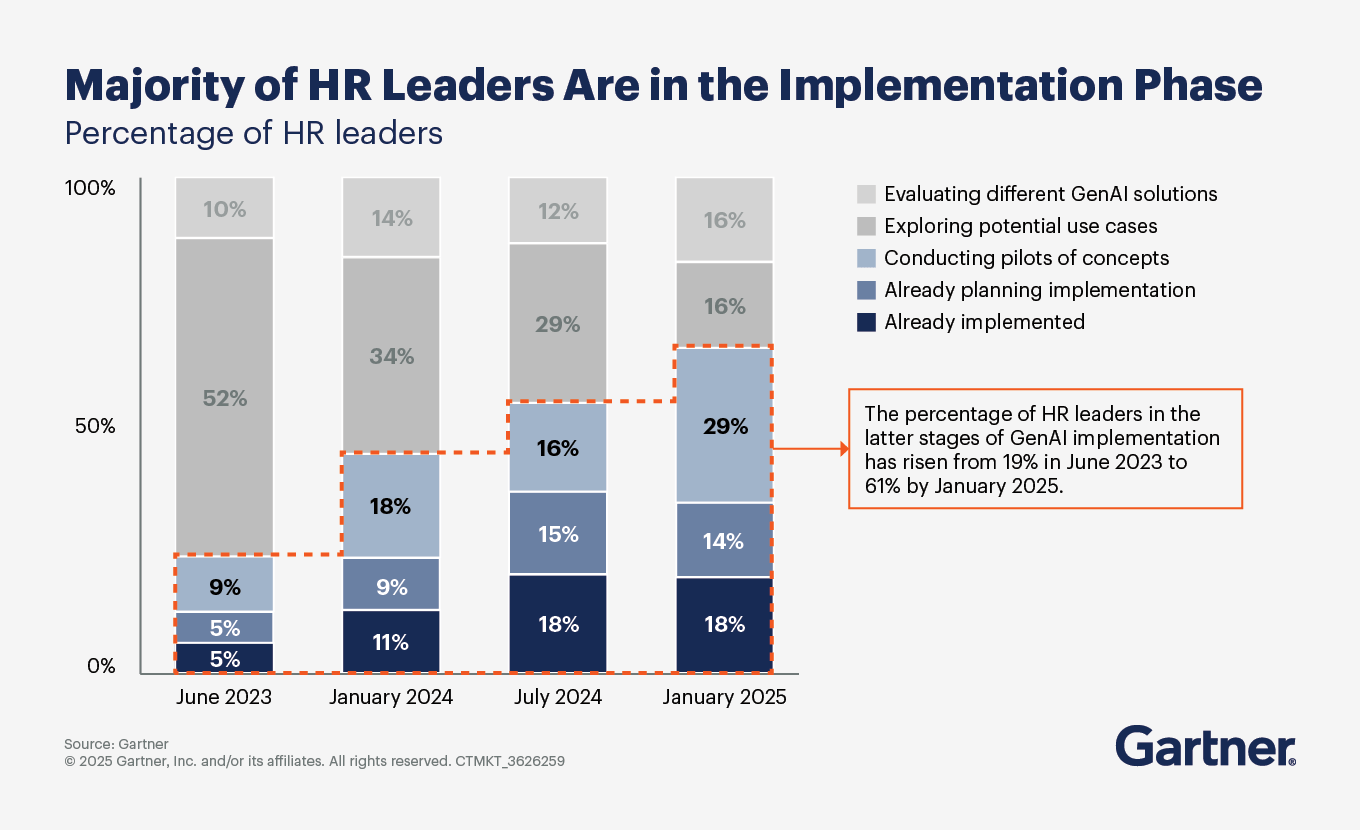
New HR roles for the AI era
AI integration will create new HR roles, including:
Product leader for AI in HR: Owns HR’s AI strategy and connects HR to enterprisewide AI efforts
GenAI expert: Leads GenAI initiatives
Head of HR innovation: Drives HR innovation
Digital HR operations lead: Oversees AI-powered service delivery
Preparing for workforce disruption
Sixty-two percent of CEOs believe AI will define the next business era. Yet only 21% of CIOs say their organizations prioritize mitigating AI’s impact on employees — exposing gaps in skills and human-centric approaches.
CHROs must lead this transformation — it’s a top priority. That means evolving HR service delivery and preparing the workforce for an AI-enabled future. Without active CHRO involvement, organizations risk negative outcomes and a diminished HR role.
Prepare your teams and workforce by:
Upskilling employees. Add AI skills to development plans.
Identifying AI talent. Find and nurture employees with AI expertise.
Preparing for role augmentation. Help staff adapt to AI-augmented roles.
Managing dual talent strategies. One for “now” and one for “next.”
By benchmarking, planning and focusing on collaboration, education and high-value use cases, HR can fully leverage AI. Upskill employees and create new roles to ensure a smooth transition into the AI-driven era.
Set realistic expectations — and a strategic roadmap — for AI’s impact on the workforce.
AI is set to fundamentally change how work gets done — and what jobs look like. As of January 2025, HR leaders estimate that 37% of the workforce will be impacted by generative AI (GenAI) in the next two to five years, up from 27% in November 2024.
Despite concerns about job loss, Gartner expects the global jobs impact from AI to remain neutral through 2026 — with no net decrease or increase. By 2036, AI will drive the creation of over half a billion net-new human jobs as tasks and roles evolve.
AI’s impact on the workforce
AI will reshape how organizations hire, develop and leverage talent. To stay ahead, HR and senior leaders must define an AI talent strategy — including both AI talent acquisition and AI tools for HR — to prepare for coming talent transformations.
CHROs must also rethink how work is designed and delivered. Gartner’s 2026 CHRO top priorities emphasize the need to shape work in the human-machine era, where AI agents and human workers co-deliver outcomes.
Gartner sees two main ways AI will affect the workforce
Role shifting within professions: AI will automate routine tasks, reducing headcount needs for the same output. Leaders should expect to redesign jobs into fewer, multiskilled generalist roles that offer broader responsibilities and a stronger employee value proposition.
Emergence of specialized roles: As performance expectations rise, organizations must use AI to compete. New, highly specialized roles will emerge, blending business and technology skills — talent that is currently scarce.
Blended workforce models will become the norm. CHROs must move beyond bolt-on AI tools and begin designing work where humans and AI agents collaborate seamlessly.
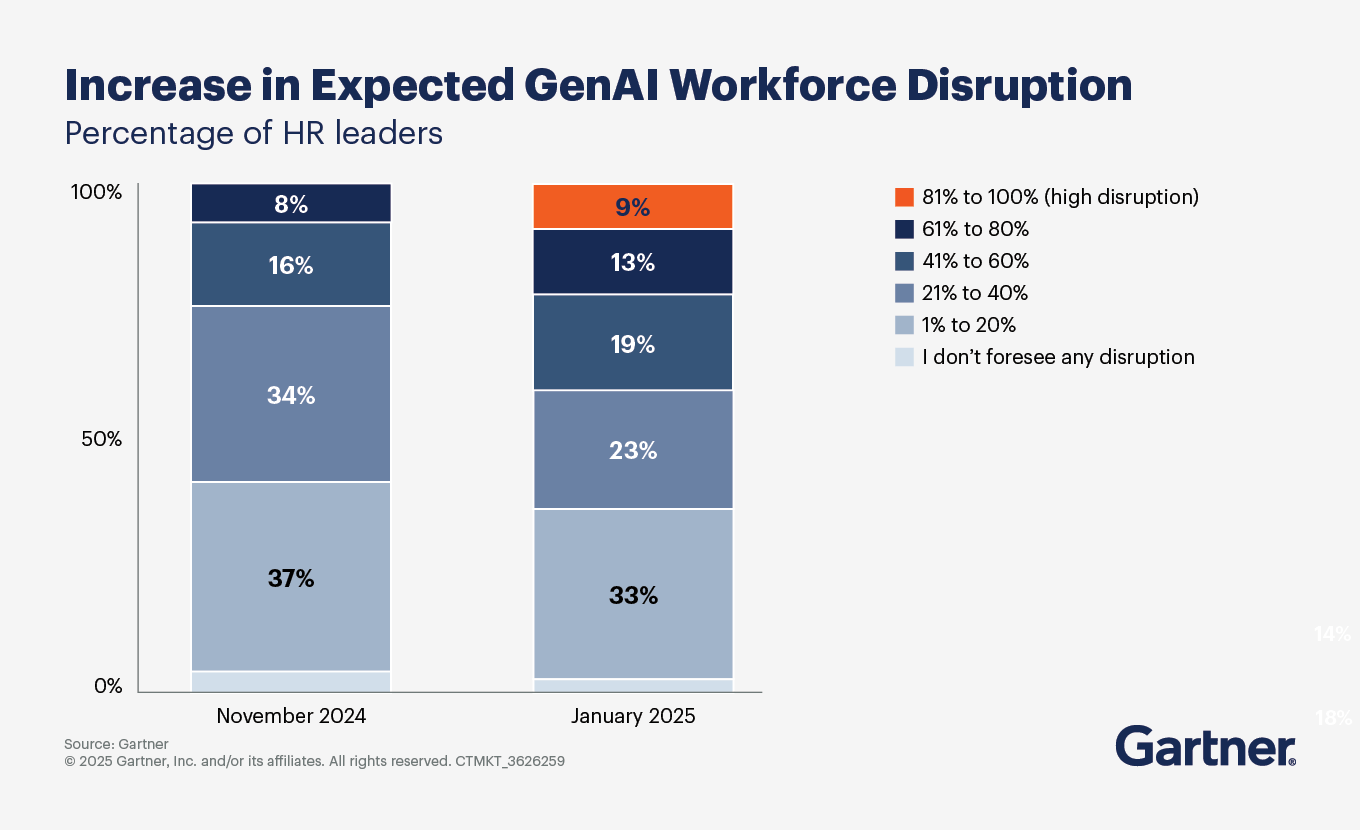
Action steps for HR leaders to prepare your organization
Identify roles that can benefit most from AI-driven productivity in the near term.
Build a roadmap to increase AI literacy across the workforce.
Collaborate with business leaders to assess AI’s long-term impact on jobs and roles.
Redesign and co-create future roles in partnership with employees and business leaders.
Establish dual talent strategies for immediate needs and future human-AI scenarios.
Use AI to personalize development, onboarding and career paths to support evolving roles.
Prepare critical roles and capabilities for AI in HR.
CHROs are under pressure to unlock AI’s transformative potential in HR. To realize true benefits, they must go beyond technology and address nontechnical challenges — skills, roles and mindset — to ensure the HR function is ready for AI.
CHROs must evolve the operating model to reflect a blended human–AI workforce. That means redesigning how work gets done, who does it, and how HR delivers value across the enterprise.
Preparing HR for an AI-augmented future
Building an AI-ready HR function requires CHROs to lead open, concrete discussions about the changes or additions needed in HR roles and capabilities. This includes redefining responsibilities, fostering new skill sets and cultivating a forward-thinking mindset across the function.
CHROs should also establish dual talent strategies — one for “now” and one for “next” — to balance short-term impact with long-term transformation. This approach helps HR stay agile while preparing for deeper shifts in work design and delivery.
Key roles for an AI-ready HR
HR technologist: This role bridges HR, AI experts and business stakeholders throughout the AI system life cycle — from ideation and development to deployment and operation. HR technologists ensure AI solutions address real business priorities; identify and pursue valuable use cases; and supervise AI-driven decision making. They also guide the team to use AI in ways that are ethical, responsible and compliant with both internal policies and external regulations. As pioneers, they help others in HR understand and apply AI to improve processes and outcomes.
HR product owner: As AI technologies evolve, the HR function benefits from a product ownership approach. The HR product owner is responsible for designing and redesigning HR services with technology, especially AI, to optimize and automate the employee experience. They manage how technology impacts every stage of the employee journey, focusing on critical milestones rather than just HR processes. While they shape the vision and design, service delivery may reside with other teams.
Strategic talent leader (HRBP): As AI agents take over transactional tasks, HRBPs must shift into strategic talent leaders. This role focuses on workforce planning, capability building and aligning talent strategy with business goals, not just supporting day-to-day operations.
Digital HR operations lead: This role oversees AI-powered service delivery, ensuring that Tier 0 and Tier 1 activities are handled by AI agents while maintaining quality and compliance.
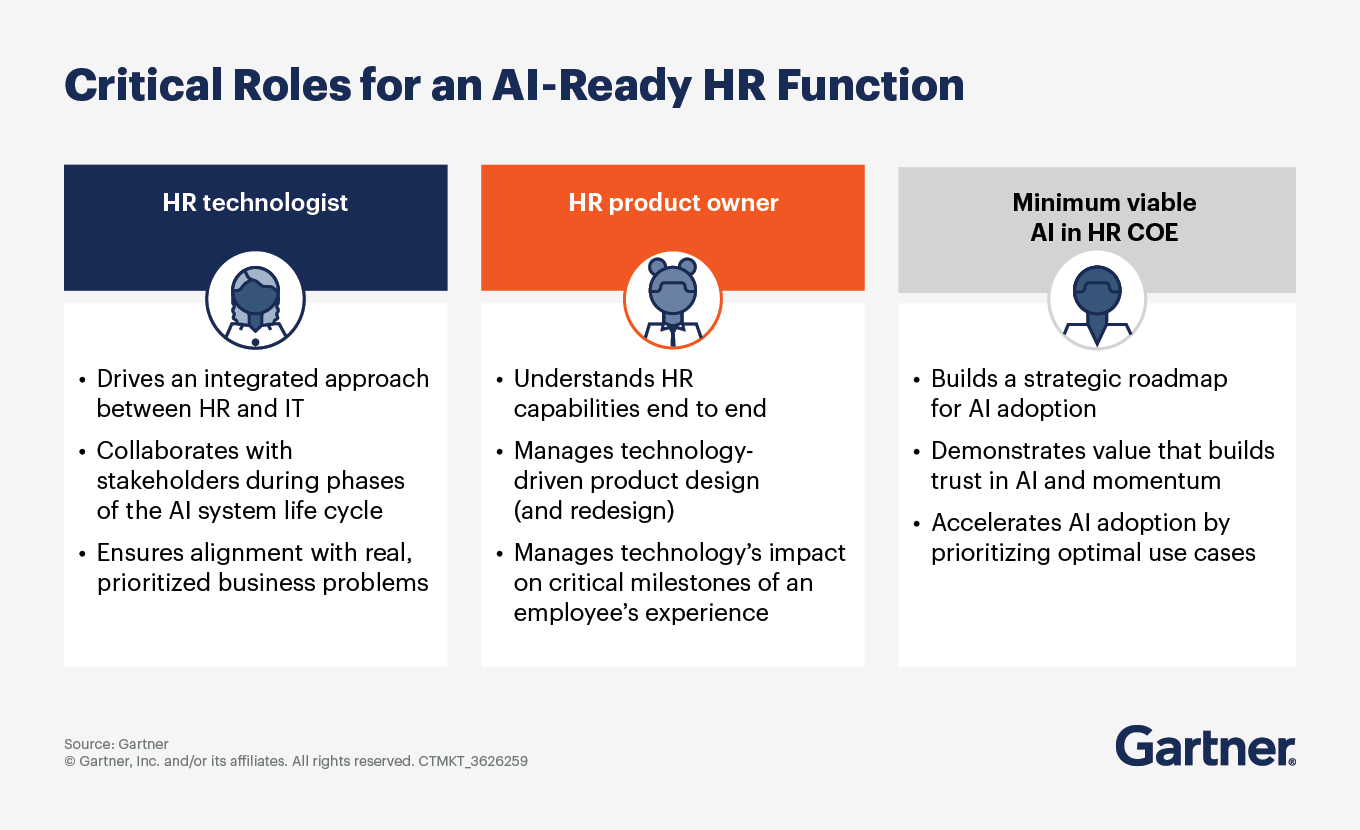
Establishing a minimum viable AI center of excellence (COE)
Launching a minimum viable AI COE is a practical first step for HR to demonstrate AI’s value, build trust and accelerate adoption. This team, led by the product leader for AI in HR, should include global product owners; HR data and analytics experts and cross-functional partners from IT, compliance, legal; and even early AI adopters from other business areas like marketing.
The AI COE should:
Ensure executive alignment on how AI supports the organization’s strategic vision and business goals
Educate the HR function on AI’s value, potential and ethical considerations
Set strategic goals and define the benefits HR wants to achieve through AI
Build a strategic roadmap for AI adoption, including practical pilot projects to build skills and momentum
Accelerate adoption by prioritizing high-impact use cases
Define clear success metrics to demonstrate early value and build credibility for AI in HR
Act as a command center for HR innovation, guiding the function through its reinvention
By focusing on evolving roles, redesigning work and establishing a robust AI COE, CHROs can lead responsibly in the AI era — a top priority for 2026. This positions HR to drive strategic impact, not just operational efficiency, in a rapidly changing environment.
Prepare your workforce — and your HR function — for the rise of agentic AI.
AI agents are autonomous or semiautonomous software entities that use AI to perceive, decide, act and achieve goals in digital or physical environments. While the terms “AI agents” and “agentic AI” are often used interchangeably, Gartner distinguishes agentic AI as a broader approach — encompassing solutions built on software entities that fully or partially qualify as AI agents.
Agentic AI has generated significant buzz for its potential to boost efficiency across business processes.
AI agents in HR
In a May 2025 Gartner webinar, 44% of HR leaders said their function plans to use semiautonomous AI agent capabilities in the next 12 months. Only 2% expect to deploy fully autonomous, unsupervised agents to replace human HR workers. Notably, two-thirds of HR leaders trust that AI agents will act in ways that benefit the employee experience.
CHROs must lead the adoption of agentic AI — not just approve it. That means ensuring AI agents are deployed ethically, strategically and in ways that enhance human performance.
AI agent adoption beyond HR
Emerging use cases for AI agents span multiple domains. However, the space is still maturing: AI agents range from simple, supervised tools to systems capable of independent decision making. Many vendors are rebranding basic chatbots and virtual assistants as “agents” without adding advanced, autonomous features.
CHROs should cut through the hype and focus on high-value, practical applications. Gartner recommends starting with supervised agents that augment — not replace — human roles.
The HR leader’s role
As an HR leader, you are critical to ensuring AI agents deliver real value — driving productivity, improving the employee and customer experience, transforming decision making and augmenting workforce skills. You will also help shape the future use cases for agentic AI across the enterprise.
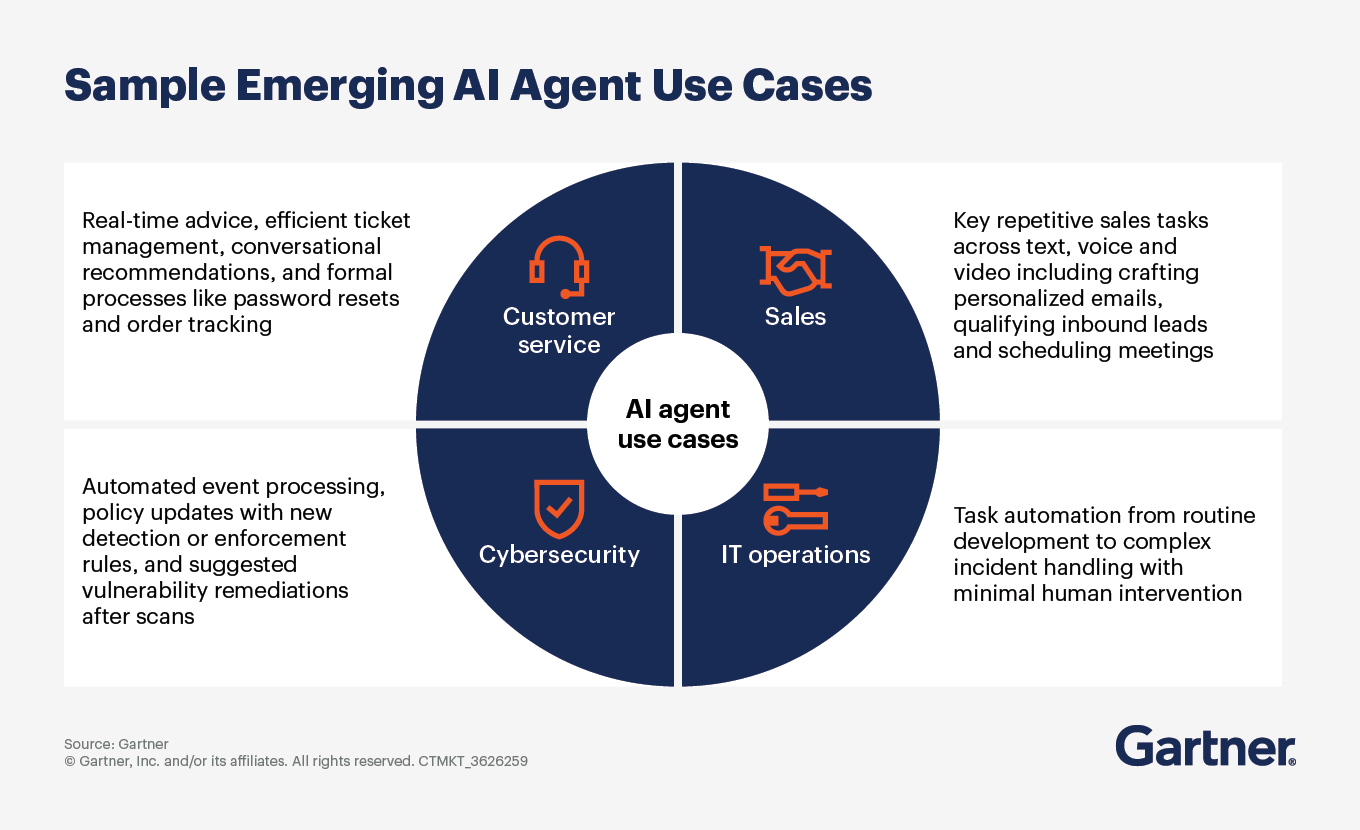
This leadership role is central to Gartner’s vision for HR in 2026. CHROs must guide the transition to a human–agent workforce, ensuring alignment with business goals and employee needs.
Action steps to prepare for the human-agent workforce
Cut through the hype by understanding the fundamentals of agentic AI.
Benchmark your organization’s approach to AI agents in HR and across the enterprise.
Assess both the opportunities and risks agentic AI presents and plan accordingly.
Identify the best use cases and technology options and take a structured approach to piloting AI agents.
Design workflows where humans and agents co-deliver outcomes, rather than replacing human roles outright.
Establish governance and success metrics to ensure AI agents enhance — not erode — trust and performance.
By grounding your strategy in fundamentals and focusing on practical, high-value applications, CHROs can lead the responsible adoption of agentic AI — a critical step in reshaping HR for the future.
Webinar | Accelerate Your AI Strategy: Promote a Human-First Approach
Attend a Conference
Join Gartner experts and your peers to accelerate growth
Gather alongside your peers in Orlando to gain insight on emerging trends, receive one-on-one guidance from a Gartner expert and create a strategy to tackle your priorities head-on.
Gartner HR Symposium/Xpo™
Orlando, FL

AI in HR FAQs
What is the future of artificial intelligence (AI) in human resources?
HR leaders are interested in understanding and experimenting with AI so they can potentially transform and augment the way HR operates — shifting from a function that delivers HR services through HR staff, to HR staff building and maintaining solutions that deliver HR solutions to end users in a fully or semiautonomous way.
In Gartner’s 2026 CHRO priorities, harnessing AI is a top strategic imperative. AI will continue to be embedded in HR technology platforms, enabling context generation, intelligent automation, natural language processing (NLP) and more. Examples include AI agents, video generation and unstructured data processing.
Why is AI important to your HR function?
AI will have an effect on the work conducted by the HR function across the employee life cycle. This impact includes HR operations and service delivery, recruiting, learning and development and talent management.
In a first step, AI will lead to new sets of employee expectations about how employees interact with HR and HR technologies.
Over time, this shift will require CHROs to redesign HR roles, workflows and service models — a key action in an AI-infused HR operating model.
What are the key benefits of generative AI (GenAI) in HR management?
HR leaders may see the human-like text generation capabilities of GenAI as a way to save time and effort for the HR team.
CHROs are interested in understanding and experimenting with GenAI to reduce resource-intensive processes, eliminate mundane tasks or even co-author HR-related content or documentation.
What is next on the horizon for AI in recruiting and hiring?
AI in talent acquisition (TA) drives automation of the recruitment process and provides decision-making support to TA professionals, hiring managers and candidates during talent sourcing, engagement, screening, interviewing and onboarding.
For example, an AI algorithm could predict which sourcing channels would most likely attract the right candidates for a specific role, decreasing your sourcing spend. Or it could take data provided on an online candidate intake form and trigger next steps.
CHROs should prioritize high-value use cases like recruiter agents and AI-driven candidate matching.
How will AI impact jobs?
AI investments will lead to the obsolescence of many tasks, while creating the need for new skills and roles. Executive leaders must work with HR to:
Set realistic expectations for AI’s impact on the workforce by examining the degree to which initial investments are transformative, paired with business activity and market projections
Define future-proof workforce plans by establishing a regular review cycle to find opportunities for multiskilled generalist roles and teams of specialists
Design blended human-AI workforce models where AI agents augment, not replace, human talent
Establish dual talent strategies to balance short-term productivity with long-term transformation
Drive stronger performance on your mission-critical priorities.
